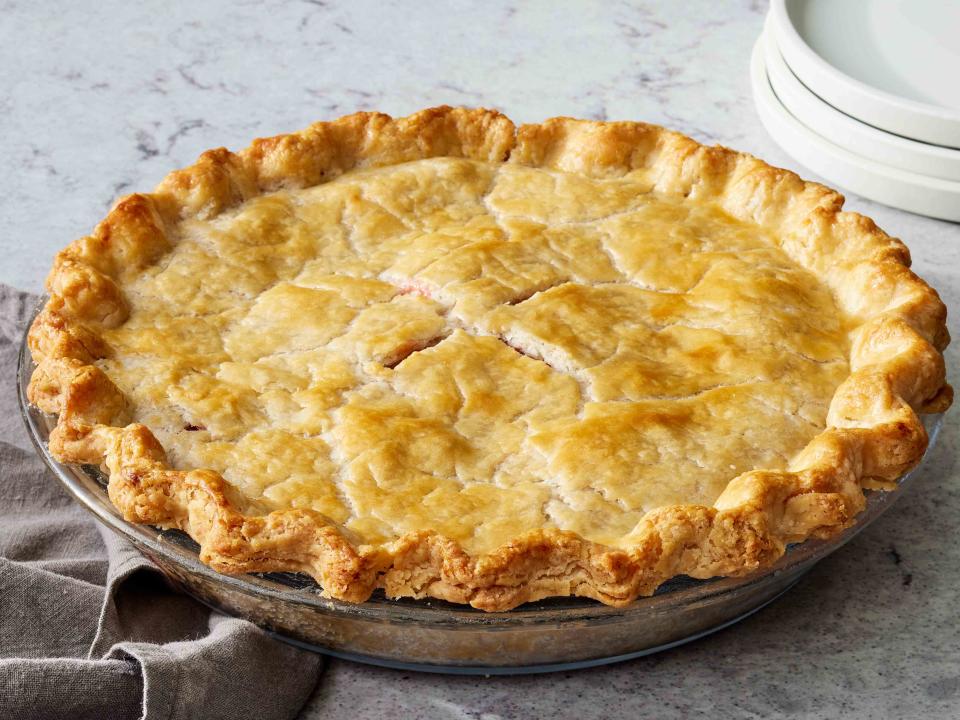The Secret Ingredient for the Flakiest Pie Crust Ever (You Already Have It)
We promise it won't make your pie reek, either.

Dotdash Meredith Food Studios
When it comes to the holidays, pies can be one of the trickiest desserts to master. Even I, a seasoned baker and food writer who worked in a bakery kitchen for years, find pie dough to be one of the most finicky, frustrating recipes to nail. We all have a platonic ideal of pie crust in our heads: buttery and flaky with a shatteringly crisp texture. How to get there...well, that's the tricky part.
On Allrecipes, we have many, many tips for how to perfect pie crust: using a cheese grater, food processor, or even a pie bird all help make for a well-made, well-baked pie crust. But I am still always on the hunt for ways to make my pies better, flakier, and more foolproof. That's why, when I came across this review on one of our top-rated pie crust recipes, I was intrigued.
"I added 1 tablespoon vinegar to the water and put in freezer. Makes for a super flaky crust."
Vinegar? In pie dough? Now that's a new one, even for me. But upon reading more, it's actually a tried-and-true tip that goes way back. Here's why adding vinegar to pie crust makes it even more flaky and tender.
Why You Should Put Vinegar In Pie Crust
Pardon me while I put my lab coat on for this little science lesson. First, you have to understand what makes a pie crust—or any dough for that matter—flaky. Pieces of fat (like butter) get trapped between layers of starch in a dough, then melt rapidly in the oven heat, creating steam and little pockets of air in the dough where the butter chunks used to be.
The number one tip most pie dough recipes will emphasize is using cold butter, cold water, cold hands—really cold everything. The colder the butter (or shortening) stays in the dough, the more it can stay self-contained until it hits the oven, creating bigger pockets of air.
The other thing you want to do is develop as little gluten as possible. Gluten is formed when two proteins (glutenin and gliadin) in wheat combine with water, making a thicker, tougher dough. Gluten is what gives baked goods their stretch and chew, two qualities you are not looking for in pie dough. This is where the vinegar comes in.
Vinegar is very acidic, and that acidity is thought to slow the development of gluten in dough. Our friends at Martha Stewart put it best: "Adding an acid, the theory goes, stops the gluten in its tracks and rescues the crust from toughness...Hindering the gluten makes the dough easier to roll out, and may even prevent it from shrinking as it bakes."
Others swear that vinegar is doing double duty and also helping pie dough get golden brown. The theory there is that the acidity keeps the dough from oxidizing, which helps it get nicely bronzed in the oven.
Both of these theories are not necessarily backed by food scientists—in fact, they've been myth-bused by our friends at Serious Eats. But, they do have the endorsement of generations of home cooks. Vinegar is a decidedly old-school trick, and found in many vintage recipes. And, more than anything else, we trust our own personal experience. Science or not, this tip has worked for several of our team members.
"I always add a tablespoon of apple cider vinegar along with the ice water when I'm making pastry," says our Senior Content Marketing Manager (and former professional baker), Frances Crouter. "Supposedly it helps with the extensibility of the dough, making it easier to roll out—but it also keeps the dough from oxidizing. The color doesn't affect the taste or anything, it's just not as appealing when you pull out the dough you made ahead of time and it looks all grayish instead of a lovely pale buttery color."
For Allrecipes Senior Editor, Devon O'Brien, vinegar was a total game-changer in pie crust. "The first time I tried it in a gluten-free dough it actually changed my mind about pie dough. It used to just be something that you needed to hold the filling but didn't taste that great—now I love pie dough because it's actually tender and flaky thanks to the vinegar."
How Much Vinegar to Add to Pie Dough
As the community member who sparked this idea, Tangee B, mentions, a little vinegar goes a long way in pie dough. A tablespoon or two will make all the difference and produce the desired effect. Mix it directly into the ice-cold water before you add that to your pie dough.
What Kind of Vinegar to Use In Pie Dough
You likely won't taste the vinegar in the final product (though some say it lends a nice tang overall), so you can really use whatever kind of vinegar you have on hand. White vinegar is most commonly called for in many older recipes, but rice vinegar and apple cider vinegar are also great choices.
You Can Use Vodka In Pie Crust, Too
Not sold on the vinegar trick? There's another liquid that can make all the difference in your pie crust too, and for similar reasons. Vodka is also thought to discourage gluten formation, meaning that pie dough made with it will turn out more tender, pliable, and easily workable. Give it a try in our top-rated Vodka Pie Crust recipe.
Whichever trick you put to the test this Thanksgiving, we have plenty of top-rated recipes for pie fillings to ensure that even if your crust comes out a bit wonky, it will still taste amazing.
Read the original article on All Recipes.

 Yahoo News
Yahoo News 
